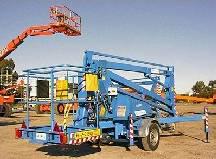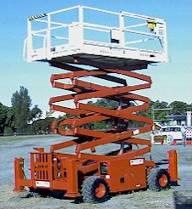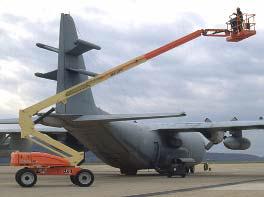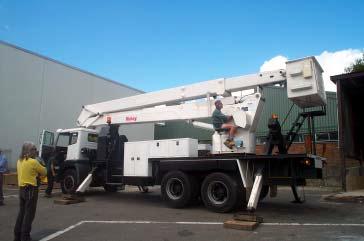Man seriously injured when elevating work platform overturned
In January 2022, a man was operating a self-propelled scissor lift which overturned leaving him with serious head injuries. Early investigations found the worker was alone, replacing rivets on metal flashings in an indoor sports facility.
These findings are not yet confirmed, and investigations are continuing into the exact cause.
Safety issues
There are various types of elevating work platforms (EWPs), including self-propelled scissor lifts, self-propelled boom-type EWPs, and truck and trailer mounted EWPs. They are important for work at height. However, there have been many serious incidents recently involving these machines. EWP operations may present a risk of injury to persons from:
- overturning
- structural failure
- contact or collision with structures, people, powerlines or other plant
- falling objects
- falls from height.

Trailer mounted EWP

Self-propelled EWP with scissor arms

Self-propelled EWP with telescoping boom

Vehicle-mounted EWP
Ways to manage health and safety
Taking steps to manage risks is a condition of doing business in Queensland. Effective risk management starts with a commitment to health and safety from those who manage the business. If an incident occurs, you'll need to show the regulator you’ve used an effective risk management process. This responsibility is covered by your primary duty of care in the Work Health and Safety Act 2011.
Use the hierarchy of controls to help decide how to eliminate and reduce risks in your place of work. The hierarchy of controls ranks types of control methods from the highest level of protection and reliability to the lowest. It’s a step-by-step approach to eliminating or reducing risks. You must work through the hierarchy of controls when managing risks, with the aim of eliminating the hazard, which is the most effective control.
Possible control measures to prevent similar incidents
Operators must be competent before operating any piece of plant, including EWPs. For boom-type EWPs with a boom length of 11m or longer, the operator must hold a high risk work licence (HRWL) or are enrolled in a training course to obtain a boom-type EWP HRWL and are supervised by the holder of boom-type EWP HRWL.
Operators must be provided with adequate training so they are familiar and competent with each type of EWP they use. EWP controls can differ between makes and models, so operators need to know four things in particular:
- where the operator's manual is kept, and what's in it
- the purpose and function of all controls
- what safety devices are fitted specific to that make and model
- how to lower the platform in an emergency.
A prestart inspection should be done before the EWP is used. It is important to keep records of the inspections and make sure there is a process for reporting faults or issues.
Some common prestart inspection items include:
- warning devices
- deadman control
- drive, steering and brakes
- any obvious faults.
Before starting work, always check the work area for any other hazards, such as overhead obstructions. All mobile plant operators should be fully aware of their surroundings while they're working. Distractions such as mobile phones and conversations with other workers should be avoided.
The most common EWP incidents happen when reversing, slewing or elevating near an obstruction or from unexpected movement near an obstruction.
Movement of the EWP should always be slow, deliberate and planned, with careful use of the EWPs proportional controls.
Start with large movements, like driving and elevating the EWP, and finish with finer controls.
If things do go wrong, other workers need to know how to use the ground controls and emergency descent devices for the type and model of EWP being used.
Keep your workers safe when using EWPs and manage the risks when working under overhead obstructions.
Safe operation
Requirements to safely operate EWP include:
- formal and refresher training of operators and record keeping of these
- ensuring the EWP has been inspected and maintained in accordance with the manufacturer’s specification. This may involve checking the logbook or maintenance manual.
- ensuring any outstanding faults or safety issues have been rectified before returning the EWP to service
- assessment of operator competency by a competent person
- elimination of EWP roll over risk through risk management
- safe work procedure development to support training and subsequent safe use
- operator harnessing where an anchor point has been provided
- lock-out procedures that exclude worker access to faulty machines.
Worker/operator obligations
The operator of an EWP must ensure:
- operation is authorised and in accordance with the safe work procedure
- faults are reported
- pre-operational checks are done
- safe working load (SWL) or maximum rated capacity of the platform is not exceeded
- operating speed is consistent with load, terrain and weather conditions and does not exceed the maximum recommended by the manufacturer
- either a lower body or full body harness is worn and is connected to the platform anchor point by a short lanyard. Where absence of an anchor point negates wearing a harness, a secondary gate restraint is engaged unless the manufacturer's design prevents ejection from the platform.
Recordkeeping
The relevant person should keep records of EWP operation, maintenance, structural inspections and training of workers for the following time periods:
- pre-operation or daily checks – one year
- routine inspection and maintenance – life of machine
- third party mechanical and structural inspections – life of machine
- EWP operator training – duration of employment.
The control measures put in place should be reviewed regularly to make sure they work as planned.
More information
- Using elevating work platforms safely - WHSQ film
- Managing the risks of plant in the workplace Code of Practice 2021 (PDF, 1.57 MB)
- Managing the risk of falls at workplaces Code of Practice 2021 (PDF, 3.9 MB)
- AS 2550.10 – 2006 Safe use – Mobile Elevating Work Platforms
- Design registration of elevating work platforms (EWPs)
- Maintenance, inspection and repair of elevating working platforms (EWPs)
- Safe support of mobile plant guide (PDF, 3.42 MB)
- Inspector guide – Mobile and operational plant – elevating work platforms (PDF, 0.34 MB)
Support for people affected by a serious workplace incident
For advice and support: